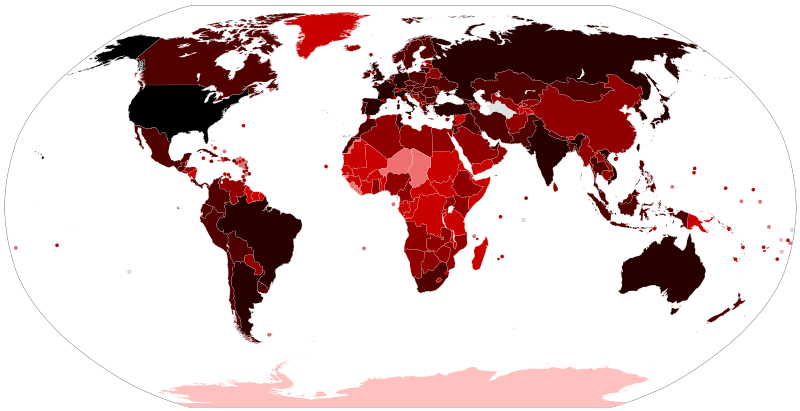 |
This
Photo by
Unknown Author is licensed under CC BY-SA
|
Humankind is now facing a global crisis. Perhaps the biggest crisis of our
generation. The decisions which people and governments would take in the next few weeks will probably shape the world for years
to come. They will shape not only our healthcare system but also our economy,
politics and culture. We must act quickly and decisively while keeping in mind the long-term consequences of our actions. We should consider not only how to overcome the immediate threat, but also what kind
of world we will inhabit once the storm passes. The storm will indeed pass,
humankind will survive, most of us will still be alive,but we will inhabit a
different world.
But here we are. at the history reveals that crises and disasters have
always set the stage for change, often for the better. The global flu epidemic
of 1918 helped to create national health services in many
European countries. The twinned crises of the Great Depression and the second
world war set the stage for the modern welfare state. On the other hand, crises
can also send societies down darker paths. After the terrorist attacks of September
11, government surveillance of citizens exploded, while George W Bush launched
new wars that stretched into indefinite occupations. Another recent crisis, the
2008 financial crash, was resolved in
a way that meant banks and financial institutions were restored to pre-crash
normality, at great public cost, while government spending on public services
across the world was slashed.
By this time, we all got to know and wonder how China defeated
the coronavirus. We all wonder how the east Asian nation with a population of
around 1.4 billion, the early epicenter, won against the coronavirus, where the
US-the global policeman and its allies in Europe struggle to catch up the pace
of the pandemic growth.
In this article, let us take a
journey through the history of mass surveillance, how nations used it, how it
has been used and how it will be shaping our lives in the future.
What is mass surveillance?
 |
This
Photo by
Unknown Author is licensed under CC BY-NC
|
Most of us have watched
the movie, “Snowden”, or would have heard about “Edward Snowden”, the secret
service officer who revealed shocking information related to the mass
surveillance done by the US government.
Reporting based on documents Snowden leaked to various media outlets
triggered a debate about civil liberties and the right to
privacy in the Digital Age. Mass
surveillance is considered a global issue.
How do the
surveillance systems operate?
Billions of
dollars are spent, by agencies such as the NSA and the FBI, to
develop, purchase, implement, and operate systems such as Carnivore, ECHELON, and NarusInsight to intercept
and analyze the immense amount of data that traverses the internet and
telephone system every day.
Since
the September 11 attacks, a vast domestic (and
to some extent, global) intelligence apparatus has been built to collect
information using the NSA, FBI, local police, state homeland security offices
and military criminal investigators. The intelligence apparatus collects,
analyzes and stores information about millions of (if not all) American (and
sometimes foreign) citizens, many of whom have not been accused of any
wrongdoing.
How China used mass
surveillance to tackle Corona?
Authorities used them to monitor
Chinese citizens, which simply gives the authorities the ability to track who
specifically gone to which precise location. Combined with data scraped from
hospital records, police files and public transportation history, linked with
national identity card, gives the authorities granular information about all of
the citizens.
They even developed a mobile
phone app named “Close Contact Detector”. The app has a database of people, who
tested positive or have symptoms. The app will inform the user if the user has
come in to close contact with any one who is tested positive. So far 200 million
people have used the app.
The future: Under-the-skin
surveillance
 |
| This Photo by Unknown Author is licensed under CC BY-SA-NC |
At this point, people may be
forced to choose health over privacy. The authorities would get every
information related to the emotions of the people.
In the same article, Prof. Harari states that “Many short-term emergency measures will become a fixture of life. That is the nature of emergencies” (Yuval Noah Harari: the world after coronavirus | Free to read, 2020). He explains that such situations can be avoided by having a self-motivated and well-informed society rather than an ignorant and over-policed society.
In the same article, Prof. Harari states that “Many short-term emergency measures will become a fixture of life. That is the nature of emergencies” (Yuval Noah Harari: the world after coronavirus | Free to read, 2020). He explains that such situations can be avoided by having a self-motivated and well-informed society rather than an ignorant and over-policed society.
Above all
the questions which stand right in front of us, this moment is “Where is our
world heading?”, “Can it ever look the same after this all over?”
M S M Aadhil
Department of Chemical and Process Engineering
University of Moratuwa.

No comments:
Post a Comment